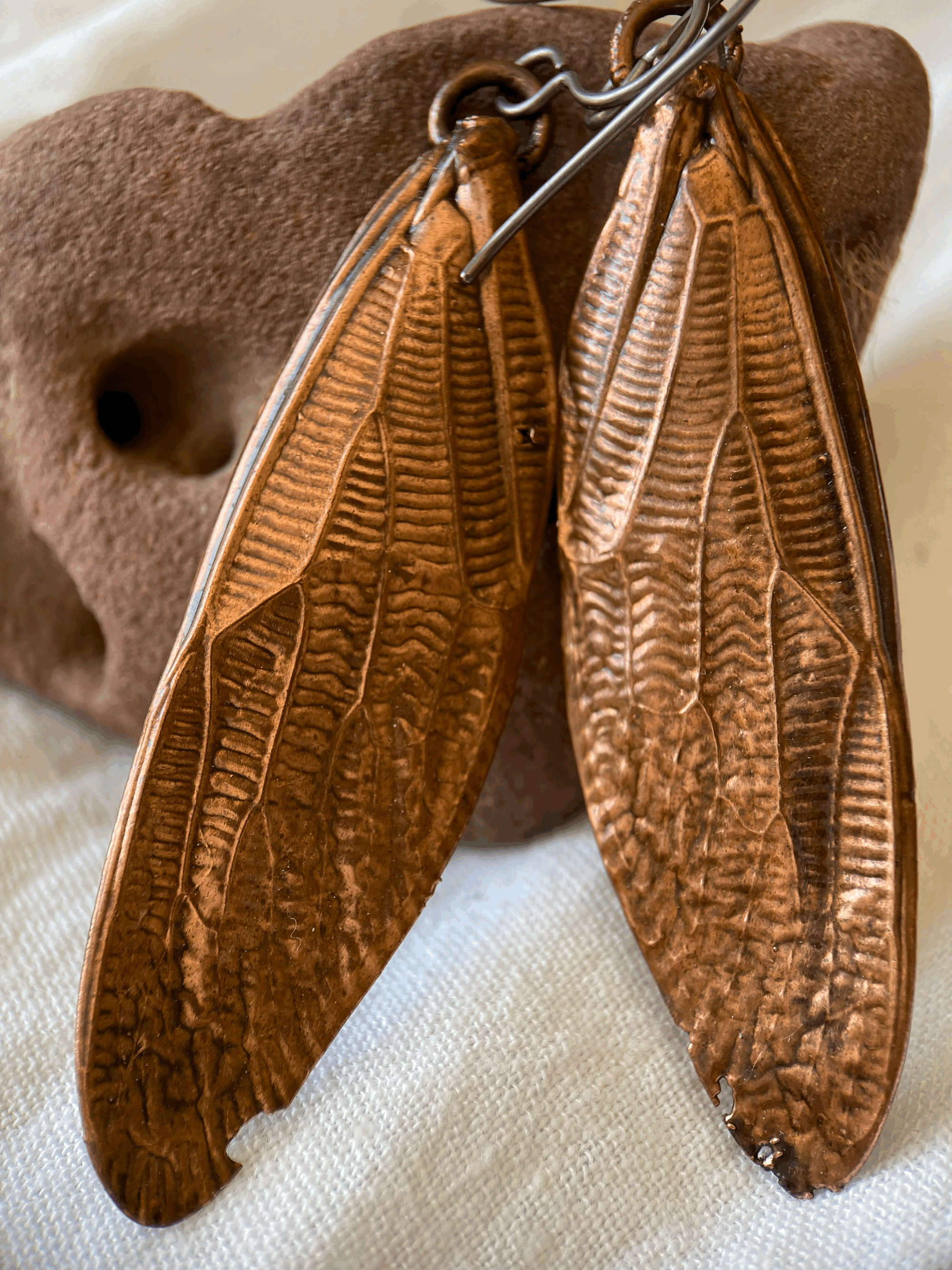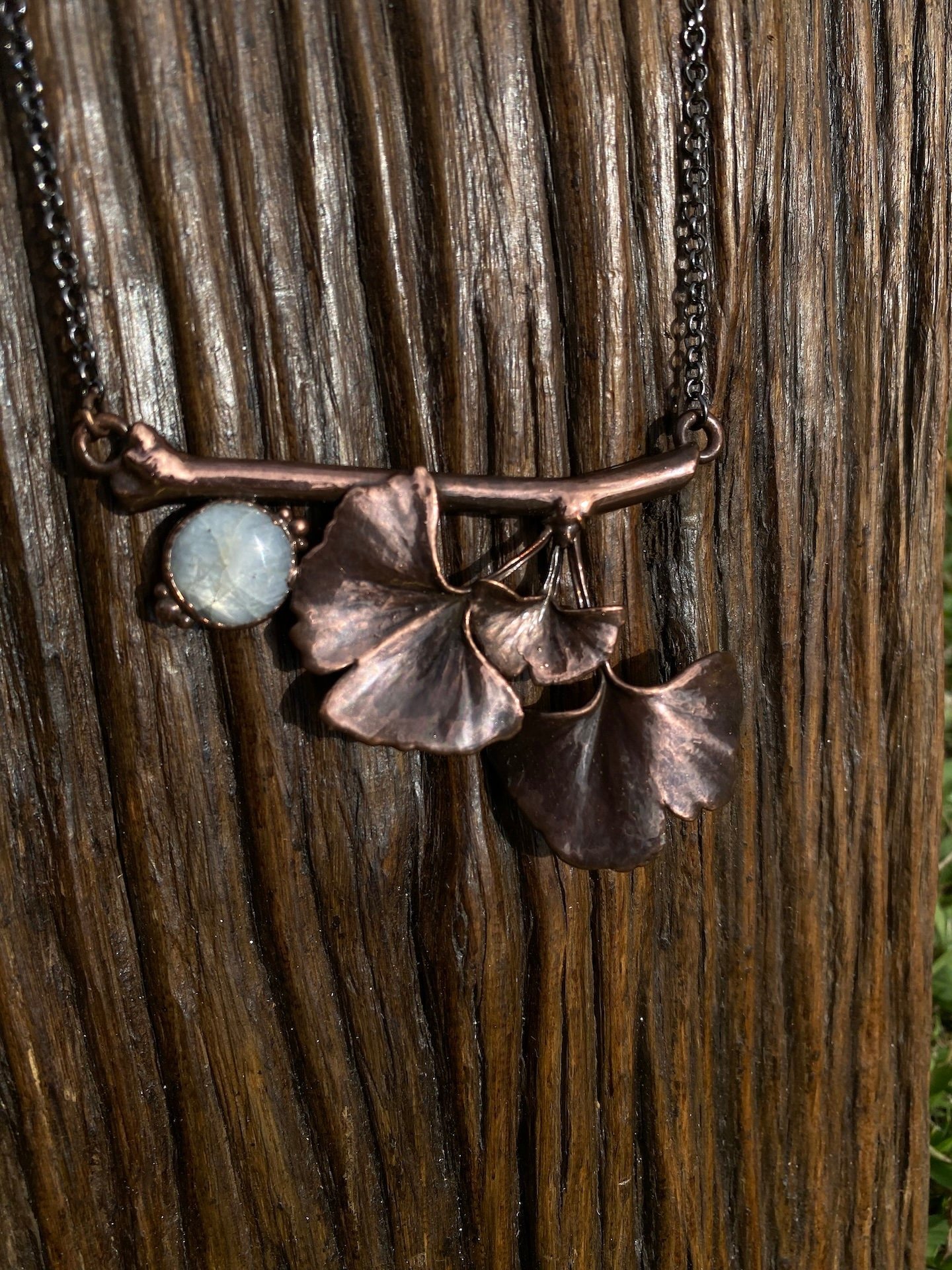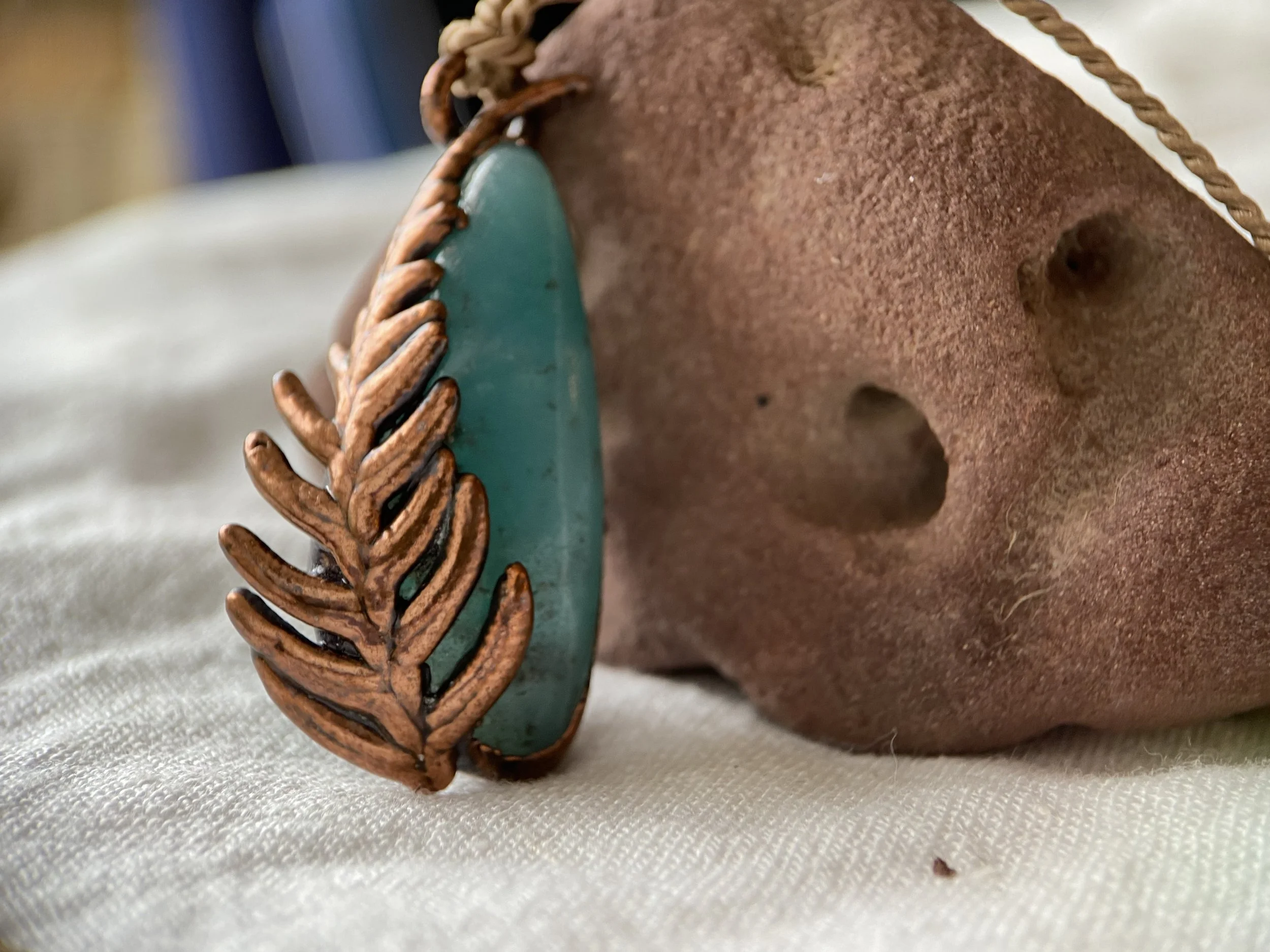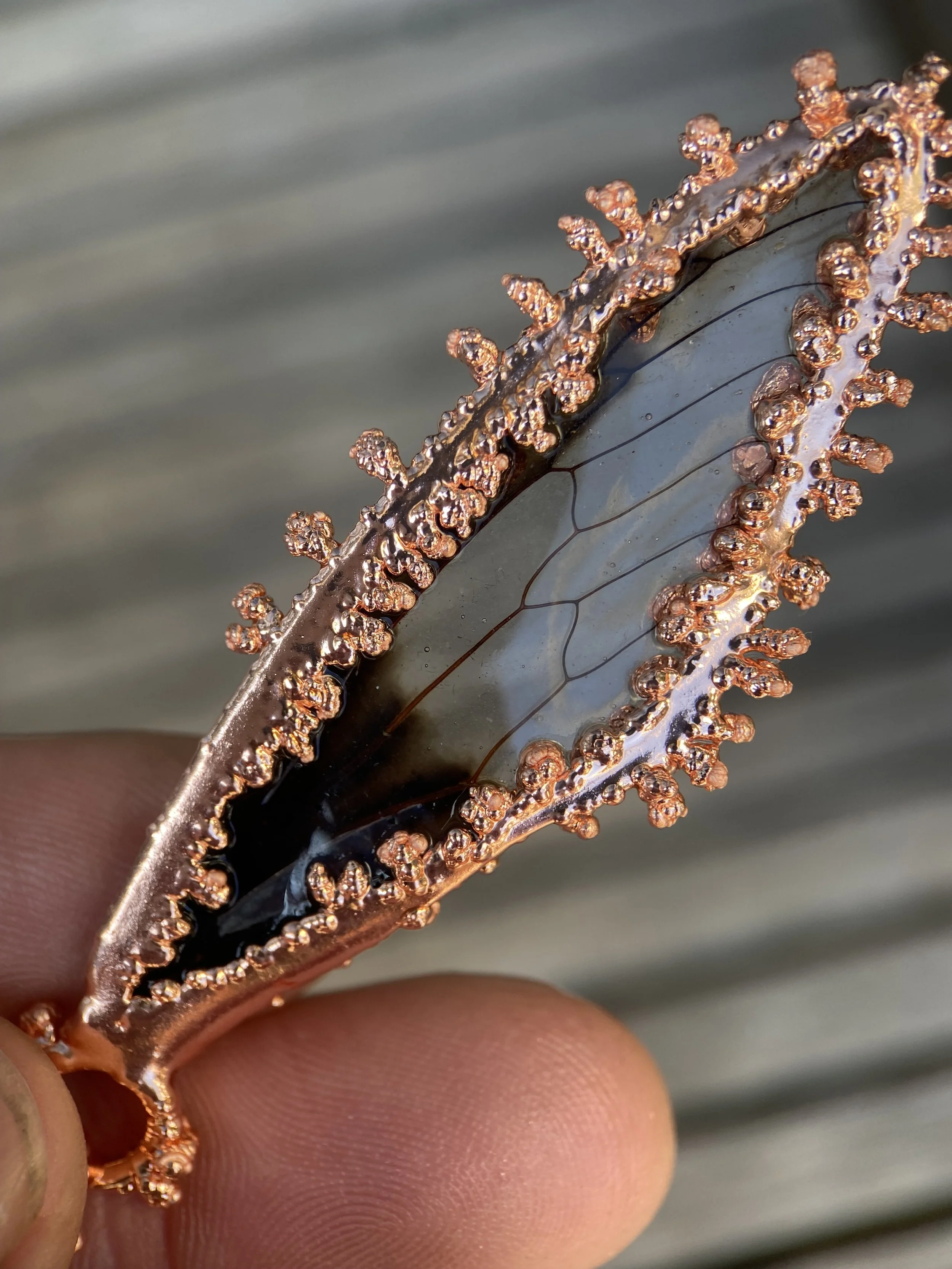The Art of Electroforming: Crafting Nature’s Beauty with Recycled Copper
In recent years, electroforming has grown in popularity among artists and jewellery designers for its unique ability to preserve and transform organic materials into durable, wearable art. Electroforming allows artists to capture the intricate details of natural objects, such as leaves, shells, insects, or just about anything you can think of, preserving their beauty and essence in a way that feels both organic and lasting. At the core, it’s a fascinating blend of art and science, and it has its own magical allure for those who appreciate nature and craftsmanship.
“The Descent of Inana” - work in progress. Cicadas are the unofficial spirit animal of electroforming artists worldwide. Their stunning details, durability, and deep symbolism make them perfect subjects for electroforming. They are plentiful during summer, and their brief lifespan after emerging from the ground offers ethical inspiration for artists, allowing them to celebrate life's beauty and diversity without causing harm.
Introduction In recent years, electroforming has grown in popularity among artists and jewellery designers for its unique ability to preserve and transform organic materials into durable, wearable art. Electroforming allows artists to capture the intricate details of natural objects, such as leaves, shells, insects, or just about anything you can think of, preserving their beauty and essence in a way that feels both organic and lasting. At the core, it’s a fascinating blend of art and science, and it has its own magical allure for those who appreciate nature and craftsmanship.
A small cutting from a friend’s gingko tree, preserved and transformed into a beautiful statement necklace, paired with a silky sapphire SOLD
What is Electroforming? Electroforming is a metal-coating process in which objects are covered in a thin, strong and even layer of metal. This is achieved through an electrochemical process, where metal particles from a solution are deposited onto an object in a controlled manner, creating a solid metallic shell over the form. While this technique has industrial roots, artists and jewellery makers have adopted it for its ability to render objects like delicate leaves or intricate twigs in stunning metallic finishes.
A copper electroforming setup features a blue copper electrolyte, an acidic mix with copper sulfate. Jewellery pieces are suspended by wires over the tub, with a small agitator pump and a solid copper anode submerged. Voltage and current are regulated by two devices on the tub's back, and a beaker of distilled water is provided for rinsing.
Electroforming differs from other metal-plating techniques because it allows for thicker, self-supporting layers, creating a durable yet lightweight piece of jewellery that can be worn daily. Copper is the most widely used metal for this process, but people also occasionally utilise silver, or gold, or plate over the copper with these or a variety of finishes to suit different tastes and styles.
A piece of real bracken fern has been preserved by copper electroforming- there are endless possibilities for what you can create with this process!
Why Electroforming? One of the joys of electroforming is how it honours the beauty found in nature’s small wonders. From a fallen leaf to a tiny shell, electroforming enables these pieces to be transformed into wearable art, bringing the intricate patterns and textures of nature into an entirely new light. For artists like myself, who are inspired by the subtleties of the natural world, electroforming is a way to celebrate nature as the ultimate artist, allowing each piece to carry its own story, drawn from the beauty often overlooked in our day-to-day lives.
Another appeal of electroforming is its durability. While organic materials tend to be fragile, covering them in a protective metal layer allows them to last. By electroforming a delicate object, it gains both a tactile presence and a longevity that raw materials alone can’t offer.
Eco-Friendly Practices in Electroforming In my studio, sustainability plays a significant role in how I approach electroforming. My jewellery is made using recycled copper, which both reduces waste and conserves resources. Copper is not only an excellent metal for electroforming due to its conductive properties, but its warm, earthy colour also pairs beautifully with organic shapes and textures, creating jewellery pieces that feel authentic and timeless.
My studio is of my own design, operates entirely off-grid and is powered by solar energy, a decision that reflects my commitment to minimising environmental impact. Working with renewable energy and recycled metals allows me to create art with a lighter footprint, adding another layer of intentionality to each piece I create.
The Process of Electroforming: Step-by-Step If you’re new to electroforming, the process can seem intimidating, but breaking it down into steps makes it more approachable. Here’s a simplified version of the process:
Creating hatpins from foraged cicada wings requires careful sealing with a water-based sealant to protect the wings and the electroforming solution.
Preparation and Sealing: To start, you’ll need to prepare the object. Organic materials, like leaves or flowers, are carefully dried and then coated in a few layers of sealant to protect them during the electroforming process. The sealant also prevents organic matter from decaying beneath the metal layer, ensuring a lasting piece of jewellery. Any gems incorporated into the pieces are also sealed.
Applying a Conductive Layer: Once sealed, the object needs to be coated with a conductive paint, typically containing powdered copper or graphite, which makes the surface of the piece electrically conductive. This step is essential, as it ensures that the metal particles will be attracted to the object during the electroforming process.
Setting Up the Electroforming Bath: The object is then submerged in an electroforming solution, usually a copper sulfate bath, along with a piece of copper to act as the metal source. When an electrical current passes through the solution, copper ions are drawn to the conductive layer on the object, depositing a layer of metal.
Control and Patience: Electroforming is a time-intensive process that requires monitoring. Depending on the size and intricacy of the object, the process can take anywhere from several hours to a couple of days. This slow build-up of metal gives artists control over the thickness and finish of the piece, allowing for a range of styles, from delicately thin layers to bold, substantial forms.
Finishing Touches: Once the electroforming process is complete, the piece is removed from the bath, rinsed, and dried. For a polished look, I sometimes add a silver or 24-carat gold finish over the copper, offering a range of styles and colours to suit different preferences. Most often I use a solution to create a “patina” on the metal, which darkens the piece. It is then gently polished to remove the excess patina, highlighting the beautiful natural textures of the piece. Each piece is then treated with a food grade metal protective coating and cured prior to selling.
Incorporating the Elements of Wabi-Sabi For me, electroforming aligns with the Japanese concept of wabi-sabi, which celebrates the beauty of imperfection, transience, and the effect of time on all things. The objects I select, like leaves or insect wings, naturally bear the marks of their life – tiny nicks, veins, and variations that add character and individuality to each piece. Electroforming captures these imperfections and preserves them in metal, highlighting that beauty doesn’t lie in uniformity but in the unique characteristics of each object.
“hag stones”- a wonderful example of the Japanese philosophical concept of Wabi-Sabi.
Challenges and Rewards of Electroforming Like any art form, electroforming has its challenges. The process requires careful handling of chemicals, precise timing, and a lot of patience. Getting the desired thickness without losing delicate details takes practice, and every object presents a new set of variables to consider. But these challenges are also what make the work so rewarding. The satisfaction of unveiling a finished piece is well worth the time and care put into the process.
A lovely accident! Dendritic growth on some recent pieces happened because of too much electrical current for too long. Even experienced artists can make mistakes, but it’s fascinating to see how electricity and copper interact when they're given freedom!
A Sustainable, Personal Art Form In a world where jewellery can often be mass-produced and disconnected from its origins, electroforming offers a deeply personal and sustainable approach. Each piece I create is not just a piece of jewellery but a small, tangible connection to nature, preserved in a way that honours its original form and meaning. Customers who wear my pieces are often drawn to them for this reason, as they feel like they’re wearing a part of the natural world – something both grounding and inspiring.
Conclusion Electroforming is more than a technique; it’s a journey of discovery, patience, and appreciation for the natural world. By transforming ordinary leaves, shells, or other found objects into wearable art, electroforming allows us to carry a piece of nature with us, a reminder of the beauty that exists in the tiny, often overlooked details of our world. For those interested in jewellery that honours nature and sustainability, electroforming offers a unique and meaningful approach, where every piece carries a story, preserving both the artistry of the natural world and the care taken to honour it.








